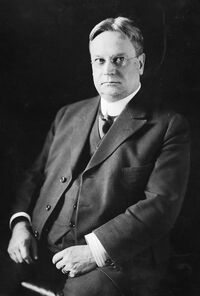| Hiram Johnson | |
|---|---|

| |
| 31st President of the United States | |
| In office June 18, 1925 – March 4, 1929 | |
| Vice President | vacant |
| Preceded by | Robert M. La Follette |
| Succeeded by | Herbert Hoover |
| 25th and 28th Vice President of the United States | |
| In office March 4, 1925 – June 18, 1925 | |
| President | Robert M. La Follette |
| Preceded by | Calvin Coolidge |
| Succeeded by | Charles Curtis |
| In office March 4, 1913 – March 4, 1917 | |
| President | Theodore Roosevelt |
| Preceded by | James S. Sherman |
| Succeeded by | Henry Cabot Lodge |
| Personal details | |
| Born | Hiram Warren Johnson September 2, 1866 Sacramento, Upper California, the |
| Died | August 6, 1945 (aged 78) Springfield, Illinois, the |
| Political party | Progressive Party (1912–45) |
| Other political affiliations |
Republican Party (1910–12) |
| Spouse(s) | Minne McNeal (m. 1887) |
| Children | 2 |
| Occupation | Politician |
| Religion | Christianity (Episcopalianism) |
Hiram Warren Johnson (September 2, 1866 – August 6, 1945) was the 31st President of the United States (1933–1941). Elected in 1910 as the Governor of Upper California (1911–1913) from the Republican Party, Johnson later co-founded the Progressive Party and was elected as the 25th Vice President of the United States (1913–1917) in 1912.
An isolationist, Johnson relationship with then-President Theodore Roosevelt was severely deteriorated prior to World War I over the foreign issue due to the latter's pro-war stance. Together with Wisconsin Senator, Robert M. La Follette, Johnson was the leading figure of "Peace Progressives", the isolationist wing of Progressive Party who opposed the U.S. entry to World War I. Following Theodore Roosevelt's death in March 1929, Johnson became the leader of the right-wing of Progressive Party.
Johnson was elected again as the 28th Vice President in 1924 as the running mate for La Follette. Only four months after assuming office, La Follette suddenly died of cardiovascular disease on June 18, 1925. Johnson then stepped up as the 30th President of the United States. During his administration, Johnson continued most of his predecessor's programs. He signed major legislation, such as outlawing of child labor and regulating food safety control by the creation of the Food and Drug Administration, and experimented on the nationalization of electric utilities.
